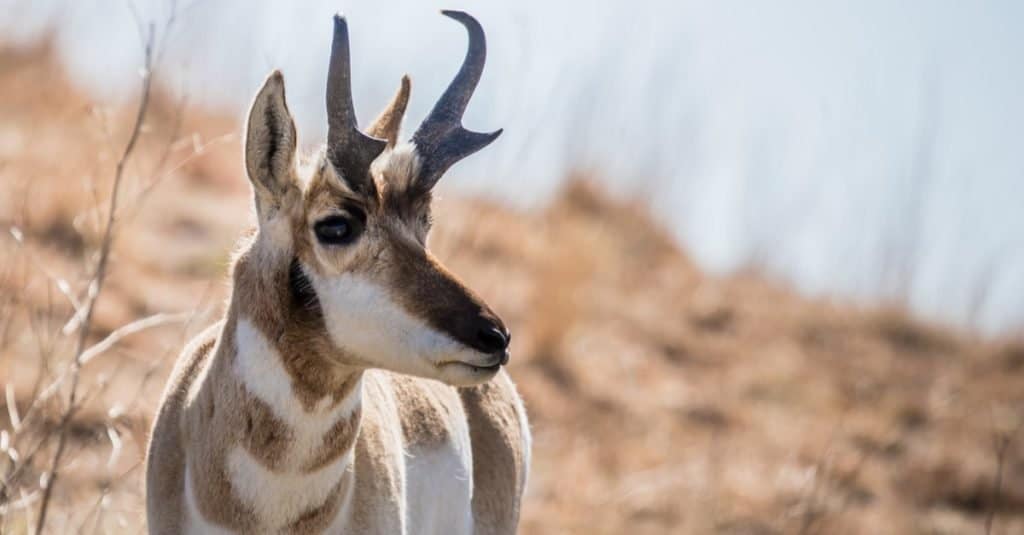Don’t get me wrong- if you step into your neighborhood barbeque, it’s likely that you aren’t going to see any antelope meat frying up on the grill. But, as they say, don’t knock it ’till you try it! This interesting meat has a pretty colorful history in the culinary world. Known to be difficult to perfect, this game meat is also said to be quite delicious when properly prepared. If you’re interested in learning a bit more about the good (and the not-so-good) regarding the consumption of antelope meat, this article is for you!
The Culinary History of Antelope

We can trace the consumption of antelope back to prehistoric times.
©iStock.com/EcoPic
Considering it’s likely you’ve never tried it, you probably won’t be shocked to learn that antelope meat is often considered an exotic delicacy. It has a history that is rooted, mainly, in survival. You see, in prehistoric times this meat provided nourishment to hunter-gatherer societies. They relied on these creatures, mainly due to their sheer numbers.
In regions of Africa, where antelope species of all types can be found, they have been a critical source of meat for centuries. Indigenous tribes such as the Maasai, for instance, have always depended strongly on game meat. Their hunting practices not only provided a meal but also a rite of passage to a young man’s transition into adulthood.
Meanwhile, in North America, these indigenous people hunted pronghorn. Pronghorn is this continent’s native antelope species. Before the cultivation of livestock, these served as both a prize catch and an important part of their diet. However, hunting practices shifted as westward expansion developed. As a result, bison largely replaced pronghorn in terms of dietary importance.
Present-Day Antelope Use
As you probably realize, from that point forward antelope meat consumption in North America faced a steady downward trend. That being said, our culinary world has definitely renewed its interest in game meats.
The reason for this revival is complex. Partially, it’s driven by a genuine curiosity and fascination with “authentic,” or traditional food. On the other hand, there has been a growing focus on lean protein in the modern diet. So, there has definitely been an uptick in restaurants (particularly expensive ones) across Europe and the United States adding antelope to their menus. Still, though, it is considered to be a bit niche and reserved mostly for those feeling adventurous.
The Pros of Antelope Meat

From nutritional value to ethical hunting, there are plenty of reasons to enjoy antelope meat.
©Jen DeVos/Shutterstock.com
1. High Nutritional Value
As we touched on earlier, part of the reason why game meat is making such a large culinary comeback in the first place is because of its status as lean meat. Lean means a lower fat content, which luckily does not come at the expense of high protein. Rich in essential amino acids, antelope meat fulfills a significant portion of daily protein requirements. Besides that, there are also a pretty substantial amount of vitamins and minerals found within antelope! Here are the primary ones:
- Iron
- Vitamin B-12
- Zinc
- Selenium
2. Sustainability
The question of sustainability is one that constantly arises when discussing the culinary world of today. In this realm, antelope meat actually offers some notable advantages. Unlike many factory-farmed livestock, antelopes are predominantly wild or range-fed. This natural habitat not only ensures a healthier diet for the animals but also signifies a much smaller carbon footprint. Their grazing habits further benefit the environment. Antelope feed on a pretty diverse array of plants, which helps support biodiversity!
In addition to this, the antelope’s dietary habits have an appeal within themselves. Raised in the wild, they aren’t subjected to any hormones or medications that are commonly fed to livestock. This means that the meat has a more organic flavor, and you don’t need to worry about potentially harmful additives.
3. It Can Be Delicious
Naturally, one of the benefits of eating this meat is getting to say that you did! Not everyone gets the opportunity to try antelope, so if you do, it’s well worth putting yourself out there. It is, after all, a delicacy! When properly prepared, antelope meat is described as tasting slightly like sage, with a gamey flavor familiar to Bison. It might be a shift from your usual commercial pork or beef, but the distinctness of this meat is part of what makes it so delicious!
4. Hunting Practices That Can Be Ethical
Ethical consumption is an important consideration for many. Part of the ethical nature of eating antelope meat is that it wasn’t bred from an industrial farm, something that many have issues with within the landscape of modern meats. Eating antelope meat also plays an important role in population management. Ethical hunting greatly helps in preventing overgrazing and maintaining an ecosystem that is balanced.
The Cons of Antelope Meat

Like everything else, there is a flipside to the benefits of antelope meat.
©Karel Bartik/Shutterstock.com
1. Lack of Availability
Even if you might want to try antelope meat, that doesn’t mean that it’s going to be readily available to you. It’s still, all things considered, pretty uncommon. It is not as though you could stroll into your local butcher and ask them for a cut of antelope! This scarcity comes from a number of factors, like limited farming, hunting regulations, and a general lack of mainstream demand. Still, if you can find it, it’s worth a try!
2. General Cost
We just covered the fact that it is quite rare and can be difficult to source. With those things comes a hefty price tag, especially if you place it in comparison with other, more conventional meat options. The costs involved in acquiring this meat, like hunting and transportation, probably play a big role in its final price. If you view it as a worthwhile luxury- great! But, for some, the price is a pretty big deterrent in choosing to incorporate this meat into their diet.
3. Gamey Taste
The taste of antelope meat can be phenomenal, but it does demand a certain culinary still in order to eliminate the strong gamey taste it might possess. Especially when placed next to a commercial type of meat, the flavors are very bold and present. This isn’t a great thing for everyone, and especially not for those who don’t understand how to prepare it. A common cooking problem with this meat is that it can dry out quickly under heat due to the lack of fat it possesses. If you aren’t accustomed to cooking and consuming game meats, antelope might simply not be your speed.
4. Potential Toxins
Like most wild game, antelopes graze all over the place freely. When doing so, it’s anyone’s guess the variety of plants they’re consuming. While this is something that contributes to the antelope’s acclaimed flavors, it can also pose a risk! If antelope ingests certain plants that are toxic to humans, those have the potential to make their way into the meat. The risk of this is relatively low, but it definitely contributes to the importance of thoroughly cooking this meat, as well as making sure you source it from a reliable supplier.
So, Should You Try Antelope Meat?

Eating antelope meat isn’t for everyone, but that doesn’t mean you can’t give it a go.
©Yakov Oskanov/Shutterstock.com
What you choose to incorporate into your diet is entirely up to your personal preference. Antelope, for its faults, might not be something you want to have on a frequent basis. That’s pretty understandable! However, if you have the opportunity to try it at the hands of a reputable and acclaimed chef, it is worth the adventure. Expanding your palette is something that could be recommended to everyone. And besides, it would definitely make for an interesting story!
The photo featured at the top of this post is © Yulia Lakeienko/Shutterstock.com
Thank you for reading! Have some feedback for us? Contact the AZ Animals editorial team.







